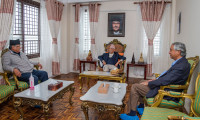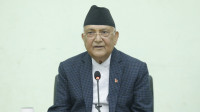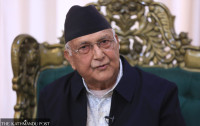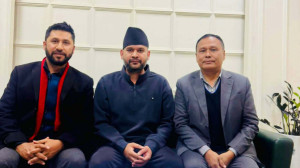Politics
Maoist manifesto for directly elected President, fully proportional system
Nepali Congress and CPN-UML, the other two major parties, are opposed to executive presidency.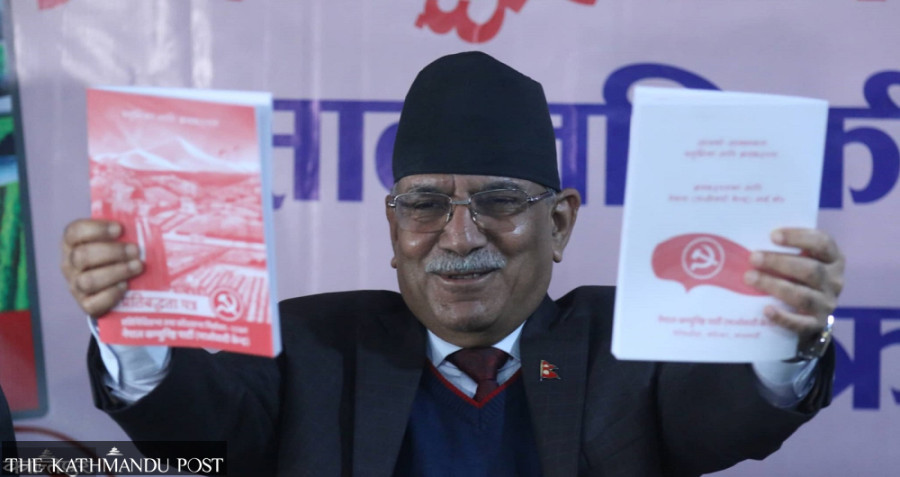
Tika R Pradhan
The CPN (Maoist Centre) that promises to emerge as the decisive third party through the November 20 federal and provincial assembly elections, reiterated its earlier stance of adopting a directly elected presidential system and fully proportional electoral system while unveiling its election manifesto on Monday.
With the Maoist Centre focusing on change in the system of governance in its election manifesto and the CPN (Unified Socialist) expressing serious concerns over the expensive elections, the pre-constitution debate on governance and the electoral system has re-emerged.
But the issue seems to be getting nowhere as two other major forces which are expected to become the first and the second largest political parties in the upcoming polls–Nepali Congress and CPN-UML—are not in agreement with Maoist Centre’s proposal.
The Maoist party, which had registered a note of dissent while endorsing the constitution in 2015, insisting on a directly-elected President, has now revived its political agenda. The party claims that its stance has become more relevant to ensure political stability, peace and prosperity.
As things stand, the CPN (Maoist Centre) alone doesn’t have the strength in Parliament to amend the constitution for a systemic change. But Maoist Centre chief Pushpa Kamal Dahal has argued that even other political parties are gradually realising the need to amend the constitution in order to ensure political stability.
“The UML was for a directly elected prime minister until before the promulgation of the constitution [in 2015], while a large chunk of the Congress leadership has also been saying that stability is not possible under the existing governance system,” said Dahal, while responding to queries of reporters after unveiling his party’s 81-page election manifesto at the party’s headquarters in Paris Danda, Kathmandu. “Therefore, I don’t think it would be impossible to amend the constitution.”
However, neither its coalition partner Nepali Congress nor UML accepts the Maoist Centre’s twin proposals—to amend the constitution to change the system of governance as well as the electoral system.
UML had lobbied for a directly elected prime minister during the tenure of the first Constituent Assembly, but changed its stance afterwards. The UML sided with Congress in supporting the parliamentary system on the condition of adopting an ‘advanced parliamentary system’.
In order to amend any of the constitutional provisions, the parties need to garner a two-thirds majority in the federal parliament.
Meanwhile, the Baburam Bhattarai-led Nepal Samajbadi Party that decided to contest the November 20 polls with the Maoist Centre’s election symbol, also unveiled its manifesto last week with similar stances–a directly elected executive head and a fully proportional electoral system.
Another major ruling coalition partner, the CPN (Unified Socialist), which was formed after breaking away from the CPN-UML, has not explicitly spoken about changing the existing electoral system unlike the Maoist Centre. But it has vowed to change the existing electoral system in its election manifesto unveiled on Monday.
Like the Maoist Centre, the Unified Socialist also reckons that the existing electoral system has become too expensive and only the candidates who can spend more money win elections.
“It’s complex and no single party can garner a majority. The resultant coalition government cannot excel in development works because of [politica]) instability,” states the Unified Socialist manifesto.
Besides a directly elected executive President, the Maoist Centre has also proposed directly elected provincial chiefs in all seven provinces, but is mum on the chief ministers.
Following KP Oli government’s ‘autocratic and unilateral rule’, some Maoist Centre leaders, however, are in favour of rethinking their party’s stance on directly elected President who, they fear, could turn into an autocrat.
The party has proposed a 165-seat House of Representatives and a 55-member National Assembly in the federal parliament. It has also proposed 330 seats for seven provincial assemblies.
Currently, the federal parliament consists of a 275-strong House of Representatives with 165 members directly elected through first-past-the- post system and 110 members elected through proportional representation system, and a 59-member National Assembly. Among the 550 members of the seven provincial assemblies, 330 are directly elected and 220 come through the proportional representation system.
Interestingly, the pro-monarchy Rastriya Prajatantra Party (RPP) seems closer to the former rebel Maoist party in the proposed governance system.
The RPP, which also unveiled its election manifesto on Monday, has proposed a directly elected executive prime minister with the monarch as the guardian of the state. Like the Maoist Centre, the RPP has also proposed a fully proportional electoral system.
The Maoist Centre has proposed a 25-member Council of Ministers composed of experts led by an executive president in the federal government and, in provinces, a provincial chief-led cabinet composed of members not exceeding 15 percent of the provincial assembly concerned.
The Maoist party and the RPP, however, are poles apart over the federal system. The Maoists want to further strengthen the three tiers of the federal structure, while the pro-monarch party wants to scrap the provincial level in favour of strong federal and local governments.
The Maoist Centre, which waged a decade-long insurgency that took the lives of over 15,000 people, claims to be the force at the head of all of Nepal’s recent political achievements. It has said the party should be given a chance to lead so as to ensure a change in the country.




 16.2°C Kathmandu
16.2°C Kathmandu
